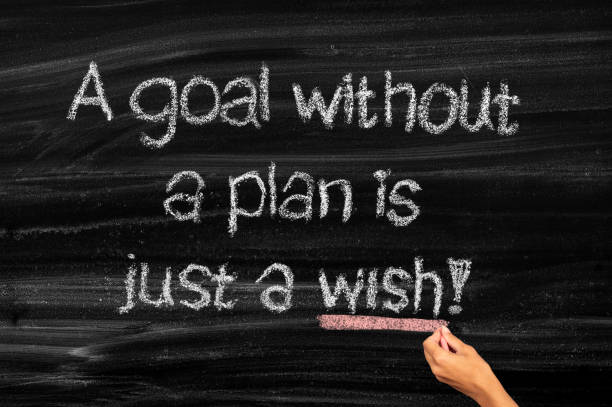“A goal without a plan is just a wish.” This phrase holds a profound truth that resonates with anyone striving for success. The mere act of wishing or hoping for something isn’t enough to make it a reality. Without a solid plan to guide you, your goals are nothing more than fleeting thoughts. In today’s fast-paced world, where everyone is racing against time, understanding and implementing the concept of planning is crucial for achieving success.
This article dives deep into the essence of planning, exploring why a goal without a plan is just a wish and how you can transform your dreams into actionable steps. We’ll discuss various strategies, tools, and mindset shifts that are essential for turning your aspirations into achievements.
The Anatomy of a Wish: Understanding the Importance of Planning
At the heart of every achievement lies a well-thought-out plan. But why is planning so crucial? Let’s break it down.
The Difference Between a Wish and a Goal
A wish is a desire or a longing for something that may or may not happen. It’s a passive thought that lacks the necessary foundation to come to fruition. On the other hand, a goal is a wish with a deadline. It’s a clearly defined objective that you actively work towards, supported by a series of actionable steps.
When you set a goal, you’re essentially taking a wish and giving it structure. You’re identifying what you want, when you want it, and how you’re going to get there. This is the fundamental difference between a wish and a goal: planning.
Why Planning Is Essential
Planning is the bridge that connects your goals to your desired outcomes. It’s the roadmap that guides you from where you are to where you want to be. Without a plan, you’re navigating without a map, hoping to reach your destination by chance. This is why a goal without a plan is just a wish.
A well-laid plan helps you:
- Clarify Your Vision: By breaking down your goal into smaller, manageable steps, you gain a clearer understanding of what you need to do to achieve it.
- Stay Focused: A plan keeps you on track, helping you avoid distractions and stay committed to your goal.
- Measure Progress: With a plan, you can track your progress, making adjustments as needed to stay on course.
- Increase Motivation: Knowing what you need to do and seeing your progress can boost your motivation to keep going.
Crafting Your Success: The Role of a Planner
In the quest to turn your wishes into reality, one of the most effective tools at your disposal is a planner. The saying “a goal without a plan is just a wish planner” emphasizes the importance of using a planner to organize and execute your goals.
The Power of a Planner
A planner is more than just a diary or a calendar. It’s a powerful tool that can help you map out your goals, set deadlines, and track your progress. By using a planner, you’re committing to a structured approach to achieving your goals.
Here’s how a planner can make a difference:
- Goal Setting: A planner helps you clearly define your goals, breaking them down into specific, measurable, achievable, relevant, and time-bound (SMART) objectives.
- Time Management: By scheduling tasks and deadlines, a planner ensures that you’re making the best use of your time, prioritizing tasks that move you closer to your goals.
- Accountability: A planner holds you accountable by serving as a constant reminder of your commitments and deadlines.
- Reflection and Adjustment: Regularly reviewing your planner allows you to reflect on your progress, identify challenges, and make necessary adjustments to your plan.
How to Use a Planner Effectively
To maximize the benefits of a planner, it’s important to use it effectively. Here are some tips:
- Set Clear Goals: Start by clearly defining your goals. Write them down in your planner and break them into smaller tasks.
- Prioritize Tasks: Identify the most important tasks and schedule them first. Use your planner to allocate time for each task.
- Track Progress: Regularly update your planner with your progress. This will help you stay on track and make necessary adjustments.
- Reflect and Adjust: At the end of each week or month, review your planner to see how well you’ve progressed. Use this time to adjust your plan as needed.
The Motivational Boost: Embracing the “A Goal Without a Plan Is Just a Wish” Quote
Quotes have the power to inspire and motivate us. The “a goal without a plan is just a wish quote” is a powerful reminder of the importance of planning in achieving success. But how can you use this quote to fuel your motivation and drive?
The Impact of Inspirational Quotes
Inspirational quotes can serve as powerful tools for personal development. They encapsulate wisdom in a few words, offering guidance and motivation. The “a goal without a plan is just a wish” quote serves as a constant reminder that action is required to turn dreams into reality.
Integrating the Quote into Your Daily Routine
Here are some ways to integrate this quote into your daily routine:
- Visual Reminders: Write the quote on sticky notes and place them in visible areas, such as your desk, mirror, or refrigerator. These visual reminders will keep you focused on the importance of planning.
- Journaling: Start your day by journaling about how you plan to turn your goals into reality. Reflect on the quote and how it applies to your current objectives.
- Affirmations: Use the quote as a daily affirmation. Repeat it to yourself each morning to reinforce the importance of planning in your journey to success.
- Share with Others: Sharing the quote with friends, family, or colleagues can help reinforce its message. It also creates a supportive environment where everyone is focused on turning their goals into reality.
The Pitfalls of Planning: Avoiding the Trap of Wishful Thinking
While planning is essential, it’s important to avoid the trap of wishful thinking. A plan without action is just as ineffective as a wish without a plan. This section explores common pitfalls in planning and how to avoid them.
The Illusion of Planning
Sometimes, people mistake the act of planning for progress. They spend so much time planning and perfecting their plan that they forget to take action. This is known as the “paralysis by analysis” trap.
To avoid this pitfall:
- Take Action: Remember that planning is just the first step. The real progress comes from taking action. Once your plan is in place, start executing it immediately.
- Set Deadlines: Assign deadlines to each task in your plan. This creates a sense of urgency and ensures that you’re making steady progress.
- Avoid Perfectionism: Don’t wait for the perfect plan. Start with what you have and make adjustments along the way.
The Importance of Flexibility
Another common pitfall is rigid planning. While it’s important to have a plan, it’s equally important to be flexible. Life is unpredictable, and things don’t always go as planned. Being adaptable allows you to adjust your plan as needed and stay on track.
To maintain flexibility:
- Expect the Unexpected: Build buffer time into your plan to account for unforeseen challenges or delays.
- Be Open to Change: If something isn’t working, don’t be afraid to change your plan. The goal is to achieve your objective, not to stick to a rigid plan.
- Regularly Review Your Plan: Regularly reviewing your plan allows you to make adjustments as needed. This keeps your plan relevant and effective.
The Blueprint of Success: From Wishes to Achievements
Transforming a wish into a goal, and then into a reality, requires a well-thought-out plan and consistent action. This blueprint outlines the key steps to turn your aspirations into achievements.
Step 1: Define Your Goal
The first step is to clearly define your goal. What do you want to achieve? Be specific about what you want, why you want it, and when you want to achieve it.
- Specific: Clearly state what you want to accomplish.
- Measurable: Determine how you will measure your success.
- Achievable: Ensure that your goal is realistic and attainable.
- Relevant: Make sure your goal aligns with your values and long-term objectives.
- Time-bound: Set a deadline for achieving your goal.
Step 2: Break Down Your Goal into Actionable Steps
Once you have a clear goal, break it down into smaller, manageable steps. This makes the goal less overwhelming and easier to achieve.
- Identify Key Milestones: Break your goal down into key milestones. These are the major steps you need to take to achieve your goal.
- Create a Timeline: Assign deadlines to each milestone. This ensures that you’re making consistent progress.
- Prioritize Tasks: Identify the most important tasks and tackle them first. This helps you make significant progress early on.
Step 3: Develop a Plan
With your goal broken down into actionable steps, it’s time to develop a plan. This is your roadmap to success.
- Create a Detailed Plan: Outline each step you need to take to achieve your goal. Be as detailed as possible.
- Set Deadlines: Assign specific deadlines to each task. This keeps you on track and ensures that you’re making steady progress.
- Identify Resources: Determine what resources you need to achieve your goal. This could include time, money, skills, or support from others.
Step 4: Take Action
Now that you have a plan in place, it’s time to take action. This is where the real work begins.
- Start Immediately: Don’t wait for the perfect moment. Start taking action as soon as your plan is in place.
- Stay Consistent: Consistency is key to achieving your goals. Make a habit of working on your goals every day, even if it’s just a small step.
- Monitor Your Progress: Regularly review your progress and make adjustments as needed. This ensures that you’re staying on track and making steady progress.
Step 5: Reflect and Adjust
As you work towards your goal, it’s important to regularly reflect on your progress and make adjustments as needed.
- Celebrate Milestones: Take time to celebrate each milestone you achieve. This keeps you motivated and focused on your goal.
- Reflect on Challenges: Reflect on any challenges you’ve faced and how you’ve overcome them. This helps you learn and grow from your experiences.
- Adjust Your Plan: If something isn’t working, don’t be afraid to adjust your plan. The goal is to achieve your objective, not to stick to a rigid plan.
Conclusion: A Goal Without a Plan Is Just a Wish
In conclusion, a goal without a plan is just a wish. Wishing alone won’t bring you closer to your dreams. To turn your aspirations into reality, you need a solid plan, consistent action, and the flexibility to adapt as needed. By using tools like a planner and staying motivated with quotes, you can stay focused and committed to your goals.
Remember, a plan without a goal is just a wish. So, take the time to set clear goals, develop a plan, and take action. With determination and persistence, you can achieve anything you set your mind to.
Now, as you reflect on your own goals and dreams, ask yourself: Are they just wishes, or do you have a plan to make them a reality? The choice is yours.

